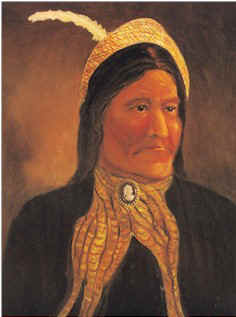 .
. . . . .
. . . . |
 .
.
 .
. . . . .
. . . . |
|
|
|
|
|
|
THE MOVIES |
|
REDISCOVERED |

VWhile no photograph of Cochise has ever been found, this is very possibly the only known true likeness of Cochise, as he appeared in 1872 Artist: W. S. Sutter. It is rumored that Sutter discovered either a photograph or a rude sketch entitled "Cochise, 1872" and created this painting from that. The original was apparently lost as efforts of several historians to track it down have been unsuccessful. Sutter's painting was only recently discovered by Charles V. Parker in 1997. |
" . . . the greatest Indian that I have ever met". Henry Stuart Turrill, U.S. Army Assistant Surgeon
" [Cochise was] straight as an arrow, built from the ground up, as perfect as any man can be." James Henry Tevis, "Arizona in the 50s"
"He carried himself at all times with great dignity, and was always treated by those about him with the utmost respect and, at times, fear." Joseph Alton Sladen, 1872 |
| To the Apaches,
he was Chis (Cheis, Chees). Early Spanish records recorded his name
as such and when Anglos first began trickling into what was then New Mexico
Territory (before that large area was split in half, becoming New Mexico
Territory and Arizona Territory), it was by this name that this remarkable
Chiricahua Apache became widly known. Gradually, though no one seems
to be able to pin down when and why the change occurred, the prefix "Co-"
or "Ka-" became attached in written reports and in common usage.
By the mid 1850s, he was known to all Americans and most Mexicans as --
Cochise. Over time, even the Apaches accepted this form and no doubt
Cochise himself became comfortable with it. Some have speculated
that the prefix was attached by the Apaches themselves as a sort of modifier
to the original name "Chis", which, according to the story, means wood
in
the Apache language. With the hard sound attached, the name supposedly
translates to "hardwood" -- possibly a reference to Cochise's great power
and legendary courage. This notion was discounted by Daklugie (son
of the Nednai chief Juh). He told Eve Ball, the Apache historian:
"Who added the prefix I do not know -- perhaps some military officer."
(excerpted from INDEH by Eve Ball, University of Oklahoma Press) Cochise's year of birth has not been definitively
determined, but most historians put it somewhere between 1812 and 1815.
In his Cochise biography, Cochise, Chiricahua Apache Chief, author
Edwin R. Sweeney tells us that Cochise's name at birth was Goci, which
was a reference to Cochise's prominent Roman nose. This was Apache
custom, to give a name at birth which would be changed in later life, usually
to something more descriptive of character, accomplishment, or reputation.
It is not known when Goci was dropped in favor of Chis, but it would be
safe to assume that this name change had occurred by the time he had progressed
from the position within the band of "dikohe" (novice) to that of
warrior.
|